Hardware Installation
Installation and initialization of ConnectX-8 SuperNIC require attention to the mechanical attributes, power specification, and precautions for electronic equipment.
Safety warnings are provided here in the English language. For safety warnings in other languages, refer to the SuperNIC Installation Safety Instructions.
Please observe all safety warnings to avoid injury and prevent damage to system components. Note that not all warnings are relevant to all models.
Note that not all warnings are relevant to all models.

| General Installation Instructions Read all installation instructions before connecting the equipment to the power source. |

| Jewelry Removal Warning Before you install or remove equipment that is connected to power lines, remove jewelry such as bracelets, necklaces, rings, watches, and so on. Metal objects heat up when connected to power and ground and can meltdown, causing serious burns and/or welding the metal object to the terminals. |

| Over-temperature This equipment should not be operated in an area with an ambient temperature exceeding the maximum recommended: 55°C (131°F). An airflow of 200LFM at this maximum ambient temperature is required for HCA cards and NICs. To guarantee proper airflow, allow at least 8cm (3 inches) of clearance around the ventilation openings. |

| During Lightning - Electrical Hazard During periods of lightning activity, do not work on the equipment or connect or disconnect cables. |

| Copper Cable Connecting/Disconnecting Some copper cables are heavy and not flexible, as such, they should be carefully attached to or detached from the connectors. Refer to the cable manufacturer for special warnings and instructions. |

| Equipment Installation This equipment should be installed, replaced, or serviced only by trained and qualified personnel. |

| Equipment Disposal The disposal of this equipment should be in accordance to all national laws and regulations. |

| Local and National Electrical Codes This equipment should be installed in compliance with local and national electrical codes. |

| Hazardous Radiation Exposure
|
The installation procedure of ConnectX-8 SuperNICs involves the following steps:
Step | Procedure | Direct Link |
1 | Check the system’s requirements. | |
2 | Follow the safety precautions | |
3 | Unpack the package | |
5 | Follow the pre-installation checklist | |
6 | (Optional) Replace the full-height mounting bracket with the supplied short bracket | |
7 | Install the ConnectX-8 SuperNIC in the chassis | |
8 | Connect cables or modules to the cards | |
9 | Identify the SuperNIC in the system |
To successfully integrate the ConnectX-8 SuperNIC into a chassis, ensure that the following system requirements are met:
Unless otherwise specified, NVIDIA products are designed to work in an environmentally controlled data center with low levels of gaseous and dust (particulate) contamination.
The operating environment should meet severity level G1 as per ISA 71.04 for gaseous contamination and ISO 14644-1 class 8 for cleanliness level.
Hardware Requirements |
| ||||
Environmental Requirements | ConnectX-8 SuperNICs are offered with two airflow patterns: from the heatsink to the network ports, and vice versa, as shown below. Please refer to the section for airflow numbers for each specific SuperNIC model. The ConnectX-8 SuperNICs are available in two airflow configurations: from the heatsink to the network ports, or from the network ports to the heatsink, as illustrated below.
| ||||
Software Requirements |
|
The SuperNIC is being installed in a system that operates with voltages that can be lethal. Before opening the case of the system, observe the following precautions to avoid injury and prevent damage to system components.
Power Down and Disconnect
Power Off the System: Ensure the system is powered down completely before beginning the installation process. This includes shutting down the operating system and turning off the power supply.
Unplug the Power Cable: Physically disconnect the power cable from the system to prevent any electrical hazards.
Electrostatic Discharge (ESD) Prevention
Use an Anti-Static Wrist Strap: Always wear an anti-static wrist strap to prevent electrostatic discharge (ESD) that could damage sensitive components. Attach the wrist strap to a grounded surface.
Work on an Anti-Static Mat: If possible, use an anti-static mat to place the SuperNIC and other components on while working. This helps to further reduce the risk of static buildup.
Handle Components with Care
Avoid Touching the Connectors: Handle the ConnectX-8 SuperNIC by its edges and avoid touching the connectors or PCB surface to prevent damage from oils, dirt, or static electricity.
Use Proper Tools: Use appropriate tools, such as a screwdrivers, to remove any screws or fasteners. Do not force components into place.
Proper Grounding
Ensure Proper Grounding: Make sure that the system and all components are properly grounded. This helps to minimize the risk of electrical shock or component damage.
Verify Grounding of Work Area: Ensure the area where you are installing the SuperNIC is grounded and free from electrical hazards.
Environmental Safety
Work in a Well-Ventilated Area: Ensure that the installation area is well-ventilated and free from excessive dust or humidity.
Ensure Clean Hands: Before handling the ConnectX-8 SuperNIC, make sure your hands are clean and free from dirt or oils that could damage the components.
The OCP 3.0 adapter card is shipped assembled either with a thumbscrew (pull-tab) bracket, an internal-lock bracket, or an ejector-latch bracket. If this form factor is suitable for your requirements, you can skip the remainder of this section and move to Installation Instructions. If you need to replace the assembled OCP 3.0 bracket with a different form-factor bracket, please follow the instructions in this section.
Due to risk of damaging the EMI gasket, it is not recommended to replace the bracket more than three times.
To replace the bracket you will need the following parts:
The new bracket of the desired form factor.
The screws supplied with the new bracket kit.
The required torx tool type as specified in the instructions.
Removing the Existing Bracket
Using the torx tool type listed in the below table, remove the screws according to the instructions per OCP 3.0 bracket type.
Internal Lock Bracket
Pull-tab (Thumbscrew) Bracket
Ejector-Latch Bracket
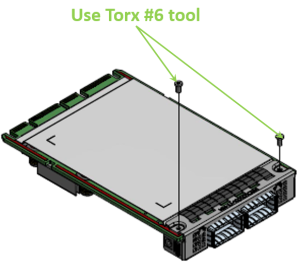
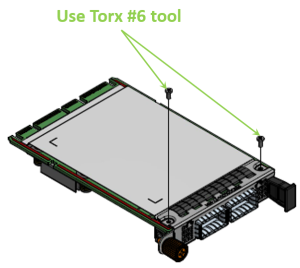
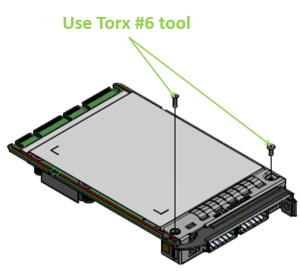
Gently separate the bracket from the OCP 3.0 card.
Internal Lock Bracket
Pull-tab Bracket
Ejector-Latch Bracket
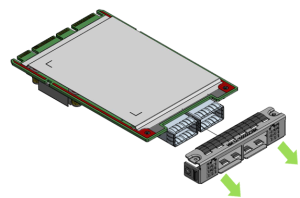
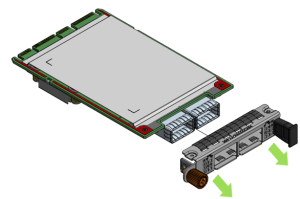
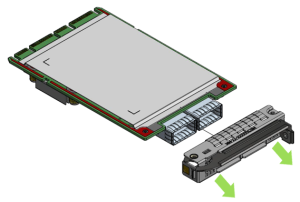 Warning
WarningBe careful not to put stress on the LEDs on the adapter card.
Save the two screws.
Installing the New Bracket
Assemble the new bracket onto the card.
Internal Lock Bracket
Pull-tab Bracket
Ejector-Latch Bracket
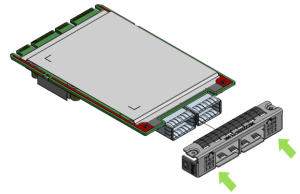
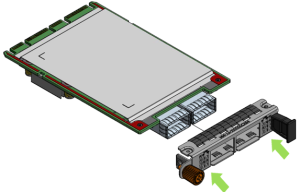
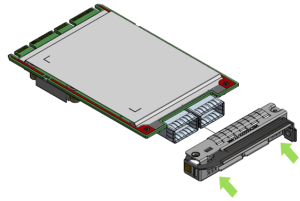 Warning
WarningDo not force the bracket onto the adapter card.
Ensure that the insulator's front edge is beneath the bracket, as shown in the below figure.
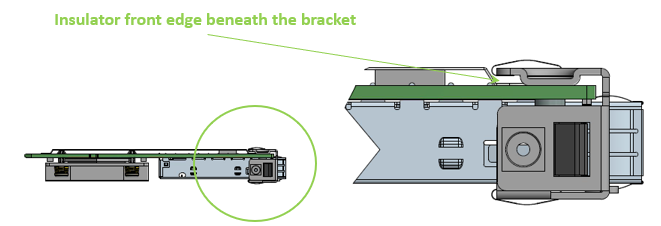
Screw on the OCP 3.0 bracket with the supplied screws that came with the new bracket kit. Use the specified torx tool type and apply the specified torque on the screws per bracket form factor.
Internal Lock Bracket
Pull-tab Bracket
Ejector-Latch Bracket
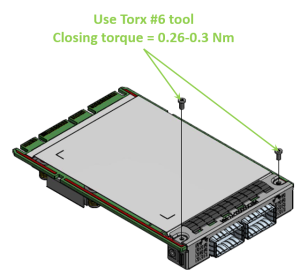
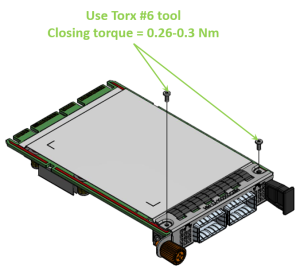
Note that one screw is flat-head 90° screw and the other is socket-head screw. Screw on the different types of screws as shown in the below illustration.
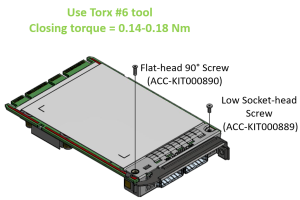
Power down the chassis: Ensure the chassis is completely powered off. Disconnect it from any power source and remove all cables.
Discharge static electricity: Put on an anti-static wrist strap or regularly touch a grounded metal surface to discharge any static electricity.
Open the chassis:
Using the appropriate screwdriver, remove the screws securing the chassis side panel or top cover (depending on the chassis model). Set the screws aside in a safe place.
Locate an available PCIe slot that is compatible with the ConnectX-8 SuperNIC. Refer to the chassis and motherboard manual to ensure the PCIe slot supports the NIC's specifications (PCIe Gen6 x16).
Position the SuperNIC: Carefully align the gold connector of the NIC with the PCIe slot. Ensure the card is lined up with the slot and the retention bracket aligns with the chassis screw holes.
Insert the SuperNIC: Gently but firmly push the NIC straight down into the PCIe slot until it is fully seated. Avoid excessive force.
Secure the SuperNIC: Use a screw (often provided with the chassis or card) to secure the card's metal bracket to the chassis. This prevents the card from moving and ensures a stable connection.
Once the SuperNIC is securely installed, reattach the chassis side panel or top cover. Fasten the screws that were removed earlier.
Connect the power cable to the chassis.
Install the network cables to the newly installed SuperNIC. For more information, refer to Networking Cable Installation.
Ensure the connections are secure before powering on the chassis.
Power on the chassis.
Verify that the ConnectX-8 SuperNIC is properly recognized by the system. Depending on the operating system:
On Linux, run
lspci | grep Mellanoxto ensure the NIC is detected.On Windows, check the Device Manager under "Network Adapters" for the presence of the new NIC.
Preparation
Power down the chassis:
Shut down the system properly, then disconnect the power supply and all cables from the chassis to ensure it’s completely powered off.
Wait 30 seconds.
Discharge static electricity:
Use an anti-static wrist strap or touch a grounded metal object regularly to discharge any static electricity that could damage the components.
Open the Chassis
Using a screwdriver, unscrew and remove the chassis side panel (or top cover, depending on the chassis design). Keep the screws in a safe place for reassembly later.
Identify the ConnectX-8 SuperNIC you wish to remove. It will be seated in one of the PCIe slots.
Disconnect the Networking Cable
To remove the networking cable, disengage the locks and slowly pull the connector away from the port receptacle. The LED indicator will turn off when the cable is unseated. Note which cables go where if they will need to be reconnected later.
Uninstall the ConnectX-8 SuperNIC
Locate the screw that secures the SuperNIC’s metal bracket to the chassis. Use a screwdriver to remove this screw, setting it aside safely.
Holding the edges of the SuperNIC, gently pull it upwards out of the PCIe slot. Apply even pressure to avoid damaging the slot or the card. Do not twist or force it out.
(Optional) Inspect and Clean the Components
If needed, inspect the PCIe slot and the NIC for dust or debris. Use compressed air to clean them, but avoid touching the connectors directly.
Close the Chassis
Once the SuperNIC is removed and any further maintenance is complete, replace the chassis side panel and secure it with the screws you removed earlier.
Reconnect Power and Cables
Reconnect the power cable and any necessary peripherals to the system.
Ensure all connections are secure before powering the system back on.
Power On and Verify
Power on the system and verify that it operates correctly without the NIC.
Depending on your operating system, you may need to check if the drivers for the NIC have been disabled or removed. On Linux, you can use
lspcito verify the card is no longer detected, and on Windows, you can check the Device Manager under "Network Adapters."
Cables and Modules
Networking Cable Installation and Uninstallation
Before connecting a cable to the SuperNIC, ensure that the bracket is fastened to the server chassis using a screw to prevent movement or unplugging of the SuperNIC when the cable is inserted or extracted.
All cables can be inserted or removed with the unit powered on.
To insert a cable, press the connector into the port receptacle until the connector is firmly seated.
Support the weight of the cable before connecting the cable to the SuperNIC. Do this by using a cable holder or tying the cable to the rack.
Determine the correct orientation of the connector to the SuperNIC before inserting the connector. Do not try and insert the connector upside down. This may damage the SuperNIC.
Insert the connector into the SuperNIC. Be careful to insert the connector straight into the cage. Do not apply any torque, up or down, to the connector cage in the SuperNIC.
Make sure that the connector locks in place.
NoteWhen installing cables make sure that the latches engage.
WarningAlways install and remove cables by pushing or pulling the cable and connector in a straight line with the SuperNIC.
After inserting a cable into a port, the Green LED indicator will light when the physical connection is established (that is, when the unit is powered on and a cable is plugged into the port with the other end of the connector plugged into a functioning port). See LED Interface under the Interfaces section.
After plugging in a cable, lock the connector using the latching mechanism particular to the cable vendor. When data is being transferred the Green LED will blink. See LED Interface under the Interfaces section.
Care should be taken so as not to impede the air exhaust flow through the ventilation holes. Use cable lengths that allow for routing horizontally around to the side of the chassis before bending upward or downward in the rack.
To remove a cable, disengage the locks and slowly pull the connector away from the port receptacle. The LED indicator will turn off when the cable is unseated.
Identifying the SuperNIC in Your System
On Linux
Get the device location on the PCI bus by running lspciand locating lines with the string “Mellanox Technologies”:
84:00.0 Ethernet controller: Mellanox Technologies CX8 Family [ConnectX-8]
On Windows
Open Device Manager on the server. Click Start => Run, and then enter devmgmt.msc.
Expand System Devices and locate your ConnectX-8 SuperNIC.
Right-click the mouse on your SuperNIC's row and select Properties to display the SuperNIC properties window.
Click the Details tab and select Hardware IDs (Windows 2022/2019/2016/2012 R2) from the Property pull-down menu.
PCI Device (Example)

In the Value display box, check the fields VEN and DEV (fields are separated by ‘&’). In the display example above, notice the sub-string “PCI\VEN_15B3&DEV_1021”: VEN is equal to 0x15B3 – this is the Vendor ID of Mellanox Technologies, and DEV is equal to 1023 (for ConnectX-8) – this is a valid NVIDIA PCI Device ID.
NoteIf the PCI device does not have a SuperNIC ID, return to Step 2 to check another device.
NoteThe list of NVIDIA PCI Device IDs can be found at the PCI ID repository.